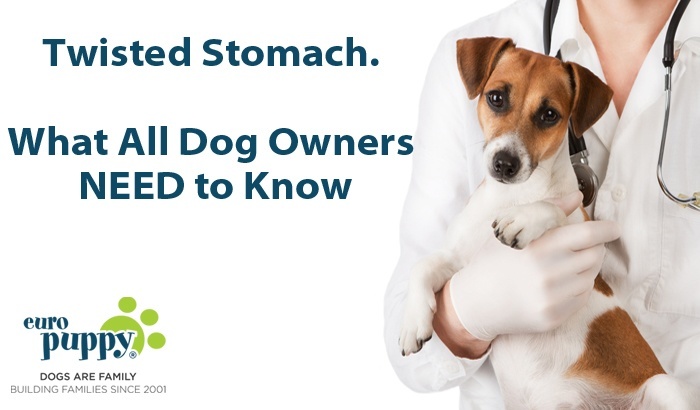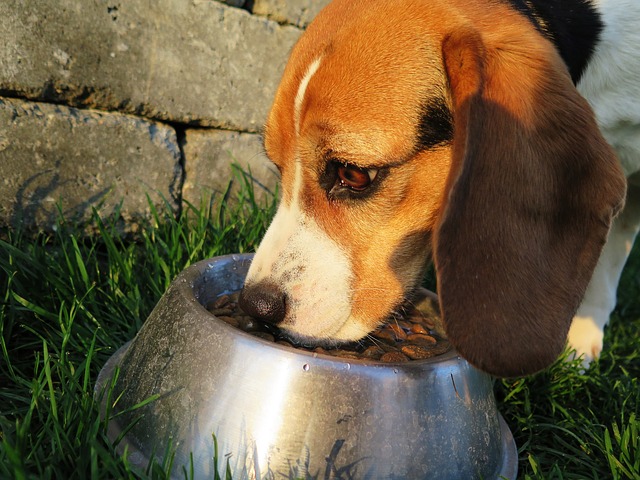Twisted Stomach. What All Dog Owners NEED to Know

We are all aware that cancer can affect our dogs just as much as ourselves. Sadly it is the most common illness that dogs can die from. But do we know enough about another of the most common conditions ? Bloat, leading to a Twisted Stomach is almost as common as cancer, and the terrible results are far more rapid and imminently life threatening.
Yet many people are not aware of this illness, and do not know the signs of bloat in dogs, what can cause bloat in dogs, or how to help reduce the risk of this happening. Hopefully by reading this, we can lower the risk of bloat and ideally prevent bloat and help save our dogs from ever getting a twisted stomach (also known as Gastric dilatation-volvulus), or at the very least know what to do should it happen!
The Facts about Twisted Stomach / GDV / Bloat in Dogs

Gastric dilatation and volvulus (gdv) or more commonly twisted stomach, is an EXTREMELY serious life threatening condition. The dog’s stomach wall becomes overstretched, expanding to a far larger size, after which the distended stomach rotates, sometimes by as much as 360 degrees. This is caused by excessive gas or fluid content in the stomach due to the blockage of food. Once the stomach fills with gas or fluid and becomes twisted, this cuts off the blood supply to the stomach and any exit for the trapped gas.
This can further lead to a loss of blood supply to the heart, potential damage to the spleen and liver, followed by shock. It can tragically lead to death within hours, or even sooner in the worst cases. It is not an understatement to say that this is the most drastic condition a dog can face and one that requires RAPID emergency treatment.
Without treatment a dog with bloat has an extremely high chance of death. Sadly even with emergency treatment and surgery the mortality rates can be as high as 60%.
The extreme seriousness and suddenness of this is why it is vital for you to know the causes, risks and symptoms, so you can help reduce the chances of a twisted stomach occurring and act rapidly if you recognize it.
The Risks that can cause Bloat in Dogs
The precise cause of twisted stomach is still debated by vets and animal scholars, but it is generally believed to be an ‘accidental illness’, one that cannot be predicted genetically, but one in which there are many factors that raise the chances of it happening.
Even though it is an ‘accidental illness’, there are types of dogs more prone to it than others.
It is far more common in large breeds, especially narrow and deep-chested dogs. These include Boxers, Basset Hounds and German Shepherds. There is an even greater chance of a twisted stomach with Gordon Setters, Irish Setters, St. Bernard’s and Greyhounds.
It is especially necessary for Great Dane owners to be aware, as this breed is considered the most at risk. As many as 40% of Great Danes will suffer from bloat in their lifetime.
It is more common between the ages of 4 and 7, with older dogs slightly more prone to it than younger ones. Males also have a far greater chance of falling foul than bitches.
However any dog can suffer a twisted stomach!
In fact, tragically it can be mostly down to way we treat our dogs that causes them to be exposed to a greater chance of getting a twisted stomach.
What can CAUSE Bloat and how to Prevent Bloat in Dogs

All of the following RAISE the likelihood your dog could get a twisted stomach.
• Having one large meal a day – instead split the meal into 2 or 3 sessions
• Eating too quickly – try to encourage your dog to eat slower (easier said than done)
• Running or playing excessively in the first hour or so after eating – this is the most crucial point! So avoid this!
• Eating or drinking too much – overweight dogs are at far greater risk
• Raised dog food bowl – this used to be a recommendation to help prevent a twisted stomach, but it is now believed to increase the risk.
• Foods containing a large amount of added oils or fats increase the risk, possibly due to delayed emptying of the stomach – lower the oil and fat amount in the diet - a calcium-rich meat meal (such as meat/lamb meal, fish meal, chicken by-product meal, meat meal, or bone meal) is highly recommended.
• Dry food is considered more of a risk factor – mix in wet food and scraps into the diet
• Stress, especially during a routine change, or new home situations – be especially cautious and try to relax and calm your dog before eating
Symptoms of Bloat in Dogs
Even if you take on board all the recommendations it does not protect your dog 100%. The risk is always there, so it is vital you keep a close eye out for any of the following potential signs of bloat. With a twisted stomach there is precious little time.
• A swollen stomach is the most obvious symptom
• Vomiting or retching, but nothing comes up
• A rapid heartbeat
• Feeling weak and limp
• Drooling excessively
• Looking increasingly anxious
• Pale gums
• If not recognised quickly, any symptom can lead to the dog collapsing
One or more these symptoms requires IMMEDIATE action to get to your local veterinarian. I don’t want to sound alarmist, but there would be a very high chance of mortality within hours if action isn’t taken.
Treatment
RACE TO THE LOCAL VETERINARY SURGERY IMMEDIATELY
Though there is a chance that the issue can resolve itself, the chance of your dog dying is high, so delaying is not worth the risk.
It is also worth knowing where your nearest emergency veterinarian is, as the most common time for this to happen is during the night, especially if your dog has an evening meal.There are a number of treatment options to treat bloat, but all are only available if you take your dog to the vet.
The vet can attempt to insert a tube into the stomach to relieve the pressure. But if this does not work the pressure will simply continue to build. Then you are faced with emergency surgery. The vet’s first priority would be to get the stomach into its correct position to relieve the pressure and re-established the blood flow, sadly even then the mortality is significant, but far, far lower than doing nothing.
For those dogs that do make it through though, it is now known that they are predisposed to stomach twisting and there is HIGH CHANCE OF RECURRENCE. Up to 80% of dogs that have suffered stomach twisting without surgery being necessary, end up getting it again.
If your dog is given surgery, your vet will most likely perform a right-side gastropexy , which by a variety of methods firmly attaches the stomach to the body wall, to prevent it from twisting inside the abdominal cavity in the future.
The seriousness of a twisted stomach cannot be understated, it can potentially happen at any time, and is swift and merciless. Any dog can suffer from it and there is little way of predicting it. But by following the preventative measures recommended, and keeping a careful eye out for any symptoms, YOU can greatly reduce the chance of this devastating condition ever happening to your dog.
